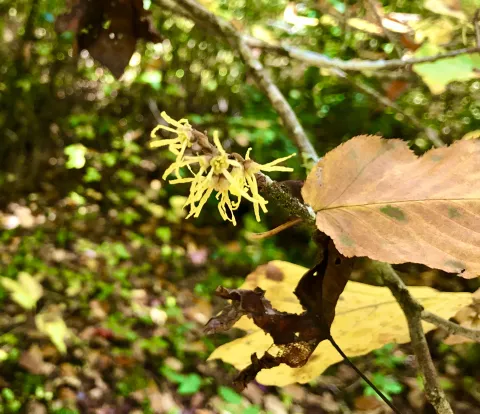Witch Hazel

Witch-Hazel not only has an odd name but has the unusual habit of flowering just before winter sets in.
By Steve Roark
Volunteer, Cumberland Gap National Historical Park
Maybe you aren't familiar with the plant, but perhaps you’ve noticed Witch Hazel as an ingredient found in after-shave lotion, skin ointments, eyewash, or hemorrhoid medication. Witch Hazel (Hamamelis virginiana) is a small tree common in our forests. It usually only reaches 15 to 20 feet in height, and tends to have a thick, crooked crown with a lot of branching. The leaves are round or oval shaped with wavy edges. The bottom of the leaf at the stem is always offset, where the leaf edges don’t meet the stem at the same level. The bark of the tree is light brown and scaly.
The name Witch-Hazel makes one wonder if there is some supernatural connection to the tree, and well….maybe. Witch likely originated in the Middle English word “wiche”, which means bendable or pliable. This bendability makes Witch-Hazel branches good for making the forked sticks called divining rods used to find underground water sources. In fact, another name for finding water in this way is “witching for water”. So perhaps there is a touch of mountain supernatural in the name.
Two other unusual features of Witch Hazel are its flowers and fruit. Unlike most trees, it blooms in early winter, usually late September through November. The flowers are yellow, thread-like, and appear twisted. When the fruit ripens in early winter, it is designed to physically disperse the small, shiny black seeds. When ready the fruit suddenly bursts open (sort of like touch-me-nots) with an explosive force that can send the seed 15 to 20 feet from the parent plant.
Witch Hazel has been considered a medicinal plant for centuries. The Indians made a tea from the leaves to treat sore throats and colds. A tea made from the twigs was rubbed on arthritic joints. Bark tea was applied to bruises and sore muscles. In modern times an extract of the plant is used as an astringent (causing tissue to shrink) in many ointments.
The wildlife value of Witch Hazel is rather low. The seeds are available from fall into winter and are consumed by grouse and squirrel. Deer will occasionally browse on the twigs and foliage.
For landscaping, Witch Hazel makes a handsome shrub and would prefer to be grown under the shade of a larger tree.
- Log in to post comments